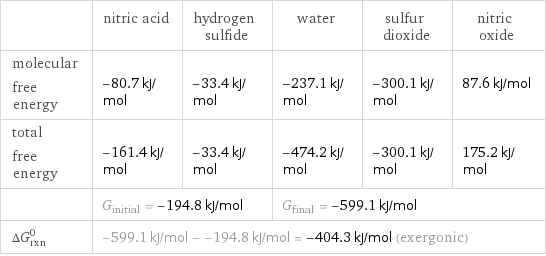Input interpretation

nitric acid + hydrogen sulfide ⟶ water + sulfur dioxide + nitric oxide
Balanced equation

Balance the chemical equation algebraically: + ⟶ + + Add stoichiometric coefficients, c_i, to the reactants and products: c_1 + c_2 ⟶ c_3 + c_4 + c_5 Set the number of atoms in the reactants equal to the number of atoms in the products for H, N, O and S: H: | c_1 + 2 c_2 = 2 c_3 N: | c_1 = c_5 O: | 3 c_1 = c_3 + 2 c_4 + c_5 S: | c_2 = c_4 Since the coefficients are relative quantities and underdetermined, choose a coefficient to set arbitrarily. To keep the coefficients small, the arbitrary value is ordinarily one. For instance, set c_2 = 1 and solve the system of equations for the remaining coefficients: c_1 = 2 c_2 = 1 c_3 = 2 c_4 = 1 c_5 = 2 Substitute the coefficients into the chemical reaction to obtain the balanced equation: Answer: | | 2 + ⟶ 2 + + 2
Structures

+ ⟶ + +
Names

nitric acid + hydrogen sulfide ⟶ water + sulfur dioxide + nitric oxide
Reaction thermodynamics
Gibbs free energy

| nitric acid | hydrogen sulfide | water | sulfur dioxide | nitric oxide molecular free energy | -80.7 kJ/mol | -33.4 kJ/mol | -237.1 kJ/mol | -300.1 kJ/mol | 87.6 kJ/mol total free energy | -161.4 kJ/mol | -33.4 kJ/mol | -474.2 kJ/mol | -300.1 kJ/mol | 175.2 kJ/mol | G_initial = -194.8 kJ/mol | | G_final = -599.1 kJ/mol | | ΔG_rxn^0 | -599.1 kJ/mol - -194.8 kJ/mol = -404.3 kJ/mol (exergonic) | | | |
Entropy

| nitric acid | hydrogen sulfide | water | sulfur dioxide | nitric oxide molecular entropy | 156 J/(mol K) | 206 J/(mol K) | 69.91 J/(mol K) | 248 J/(mol K) | 211 J/(mol K) total entropy | 312 J/(mol K) | 206 J/(mol K) | 139.8 J/(mol K) | 248 J/(mol K) | 422 J/(mol K) | S_initial = 518 J/(mol K) | | S_final = 809.8 J/(mol K) | | ΔS_rxn^0 | 809.8 J/(mol K) - 518 J/(mol K) = 291.8 J/(mol K) (endoentropic) | | | |
Chemical names and formulas

| nitric acid | hydrogen sulfide | water | sulfur dioxide | nitric oxide Hill formula | HNO_3 | H_2S | H_2O | O_2S | NO name | nitric acid | hydrogen sulfide | water | sulfur dioxide | nitric oxide